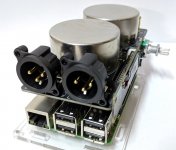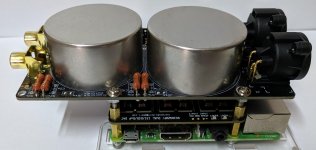Yes correct but I also think using one pair of channels say for left & the other pair for right will be a popular choice.
The AK4499 is like 2 x AK4497’s in the one package so combining channels as I suggested should make it equivalent to say a dual mono AK4497 DAC if that makes sense.
The AK4499 is rated at 798 mw so roughly double the AK4497.
Your 0.5 + 0.5 :4 should work but maybe a 1 + 1:4 would be better.
The AK4499 is like 2 x AK4497’s in the one package so combining channels as I suggested should make it equivalent to say a dual mono AK4497 DAC if that makes sense.
The AK4499 is rated at 798 mw so roughly double the AK4497.
Your 0.5 + 0.5 :4 should work but maybe a 1 + 1:4 would be better.
I agree it is the better choice to use one chip for stereo.
In case of the current-output DAC (what is 4499) we should seek the smallest value of the load seen by DAC. As I said earlier the better way is to short the output to allow the current goes without losses. But would be great to get the music during this process 🙂
Consider 1kOhm resistor load at the secondary in the both next examples.
1. Transformer with 1:4 (0.5+0.5:4) turns ratio. Roughly the load seen by DAC will be 1k/4*4=60 Ohm.
2. Transformer with 1:2 (1+1:4) turns ratio. Roughly the load seen by DAC will be 1k/2*2=250 Ohm.
As you see the first version is better in terms of impedance. Then there is another question - why not to use 1:6 or even 1:8 transformers?.. Because there are limits of the core's window from one side, unnecessary grow of the coil active resistance (DCR) from the second side and so on... The result is the common rising of THD and noise (unnecessary losses in transformer) and its impact to the sound. When you dealing with the real core's parameters there is a question not about turns ratio but for me it is more about the limits I should take into consideration to get the better Sound Quality.
In case of the current-output DAC (what is 4499) we should seek the smallest value of the load seen by DAC. As I said earlier the better way is to short the output to allow the current goes without losses. But would be great to get the music during this process 🙂
Consider 1kOhm resistor load at the secondary in the both next examples.
1. Transformer with 1:4 (0.5+0.5:4) turns ratio. Roughly the load seen by DAC will be 1k/4*4=60 Ohm.
2. Transformer with 1:2 (1+1:4) turns ratio. Roughly the load seen by DAC will be 1k/2*2=250 Ohm.
As you see the first version is better in terms of impedance. Then there is another question - why not to use 1:6 or even 1:8 transformers?.. Because there are limits of the core's window from one side, unnecessary grow of the coil active resistance (DCR) from the second side and so on... The result is the common rising of THD and noise (unnecessary losses in transformer) and its impact to the sound. When you dealing with the real core's parameters there is a question not about turns ratio but for me it is more about the limits I should take into consideration to get the better Sound Quality.
Last edited:
See Figure 83 in the data sheet.
Тhis circuit allows for a lowish output impedance without having a separate output buffer. It would be pointless without the low pass filter.
I cannot see this idea being in any way applicable to a transformer based i/v.
Sounds like the 1:4 is definitely the way to go then.
I will get some new prototype pcb’s designed to suit your transformers & the AK4499 then
report back once I have done some testing & listening.
It will be interesting to compare normal single channel & then parallel inputs to the transformers & see how they compare.
I will get some new prototype pcb’s designed to suit your transformers & the AK4499 then
report back once I have done some testing & listening.
It will be interesting to compare normal single channel & then parallel inputs to the transformers & see how they compare.
Тhis circuit allows for a lowish output impedance without having a separate output buffer. It would be pointless without the low pass filter.
I cannot see this idea being in any way applicable to a transformer based i/v.
The one only real reason why it will be not applicable is not LPF (transformer has built-in LPF) but due to power-limit of the cores I am using now. But clay-speakers says that outputs are software controlable, thus it will be checked later...
Of course the more signal level you can catch from DAC - the better possible SQ. But usually everybody is limited by the next stage input capabilities.
Additional information for using Ian's dual mono DAC (2x9038q2m) in pair with my transformers. Below is the output level depending of the load resistance at the secondary coil.
View attachment 773089
@bisesik
Is your trafo suitable for es9038pro as well? eg.: Buffalo III stereo es9038pro from Twisteadpearaudio?
One es9038pro is like 4 times es9028pro and one es9028pro is like four es9038q2m.
So base on your dual es9038q2m table to get same Vrms out for one es9038pro one should divide resistor value by eight?
I have clients who uses my transformers with 9038pro successfully. I have asked one of them regarding output voltage...
@bisesik
Where is the best place to put load resistor? As close as possible to transformer output or maybe as close as possible to XLR/RCA sockets in chasis? Or it does not matter 🙂
Where is the best place to put load resistor? As close as possible to transformer output or maybe as close as possible to XLR/RCA sockets in chasis? Or it does not matter 🙂
It is better to use the Volume resistor of your amplifier as the load to avoid excess components and RCR filters. Kind of extreme 😀
Regarding 0-20 cm distance from the secondary coil to the load resistor within chasis - I do not hear any difference.
Regarding 0-20 cm distance from the secondary coil to the load resistor within chasis - I do not hear any difference.
It is better to use the Volume resistor of your amplifier as the load to avoid excess components and RCR filters. Kind of extreme 😀
Regarding 0-20 cm distance from the secondary coil to the load resistor within chasis - I do not hear any difference.
Hymn, I do not think I get it. My amp has static (no volume knob) 48k differential impedance. How does this then relates to what you suggested: 5k1 to get 2Vrms differential?
In this case resistor is needed, no other way 🙂 The inductive resistance is too high, it is needed to lower and "stabilize" for all the frequencies range.
5k1||48k => 4.6k = ~1.9Vrms
5k5||48k => 5.1k = 2Vrms
5k1||48k => 4.6k = ~1.9Vrms
5k5||48k => 5.1k = 2Vrms
There is some delays with 4.12kOhm resistors, that is why I have installed 3.9k. Actually, it doesn't matter much in practice. If someone wants to get the precise value for the output voltage, then anyway it is needed to calibrate with the next stage impedance. Someone have 50kOhm input impedance, the second man 48K, the third 10K, fourth 1M and so on. We are not livin within the HiFi era, where DIN or IEC standards are mondatory, that is why in every case above will be different output Voltage.
I already sell these boards with transformers for $170.
I already sell these boards with transformers for $170.

I have clients who uses my transformers with 9038pro successfully. I have asked one of them regarding output voltage...
Your transformers look great.
Do you have any distortion measurements for them?
For example Jensen and Cinemag both have THD versus freq and level.
They also both have effect on distortion of varying drive impedance which is
really important.
Lastly Jensen also have required termination (RC snubber) to achieve proper Bessel LPF response, IOW
no ringing or overshoot with a square wave and linear group delay.
Also
- do you make microphone pre amp input transformers?
- quad filar OP transformers?
- What are the advantages of Toroidal core?
Thanks
- Home
- Vendor's Bazaar
- Output transformers for DACs


